|
S |
M |
T |
W |
T |
F |
S |
|
|
|
|
|
|
|
1
|
|
2
|
3
|
4
|
5
|
6
|
7
|
8
|
|
9
|
10
|
11
|
12
|
13
|
14
|
15
|
|
16
|
17
|
18
|
19
|
20
|
21
|
22
|
|
23
|
24
|
25
|
26
|
27
|
28
|
29
|
|
30
|
|
|
|
|
|
|
|
|
Forums10
Topics39,607
Posts563,352
Members14,600
| |
Most Online9,918
Jul 28th, 2025
|
|
|
|
Joined: Nov 2005
Posts: 4,598
Sidelock
|
OP

Sidelock
Joined: Nov 2005
Posts: 4,598 |
The early Belgian guild system is harder to "pin down". Often this was father son relationship. Journeyman were often hired based on the number of sons they had. It was assumed you would go to work with your father and run errands for the shop. 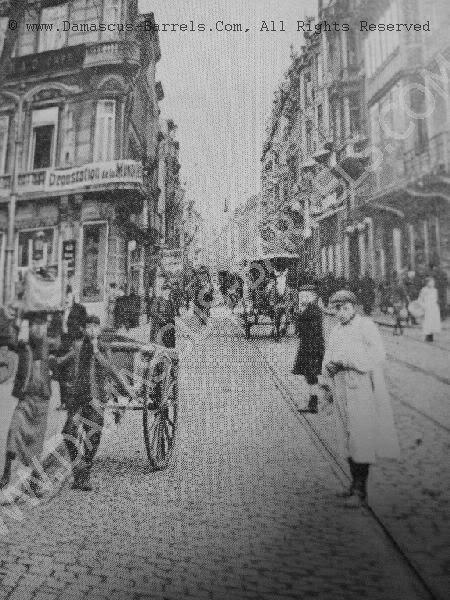 If not run errands, then most certainly do much the same work. 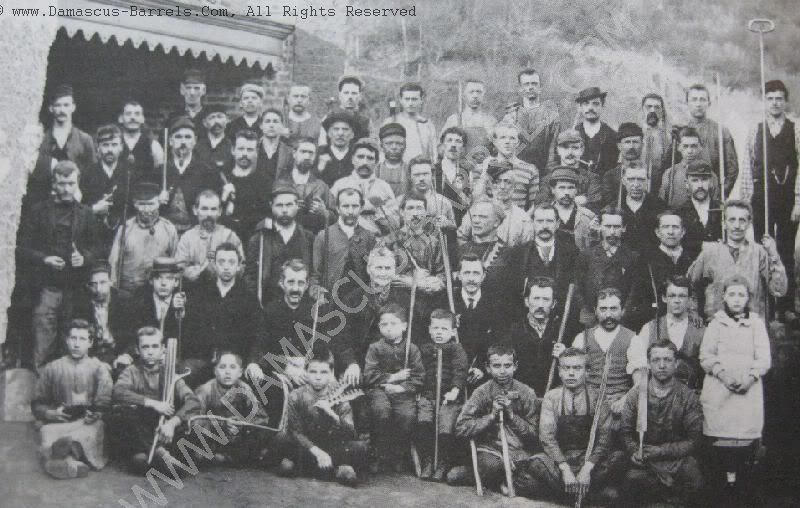 There was also in Belgium the practice of doing piece work from your home. This is a staged image for a postcard, but it does represent a certain truth about the industry. 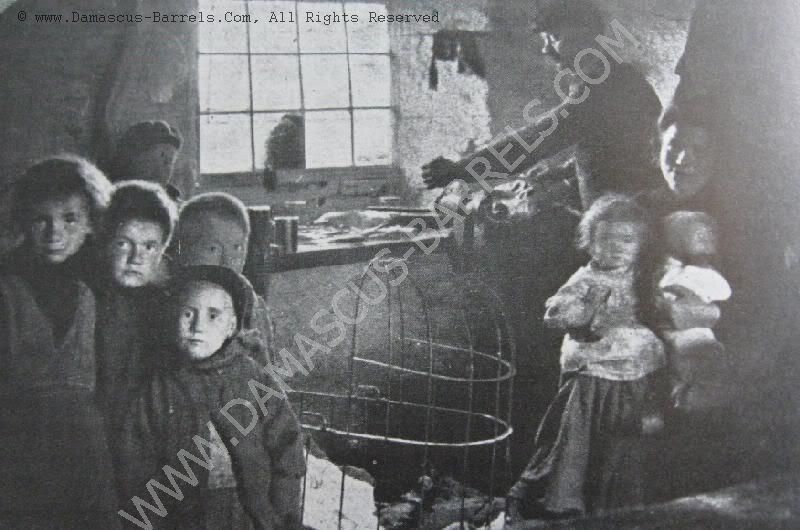 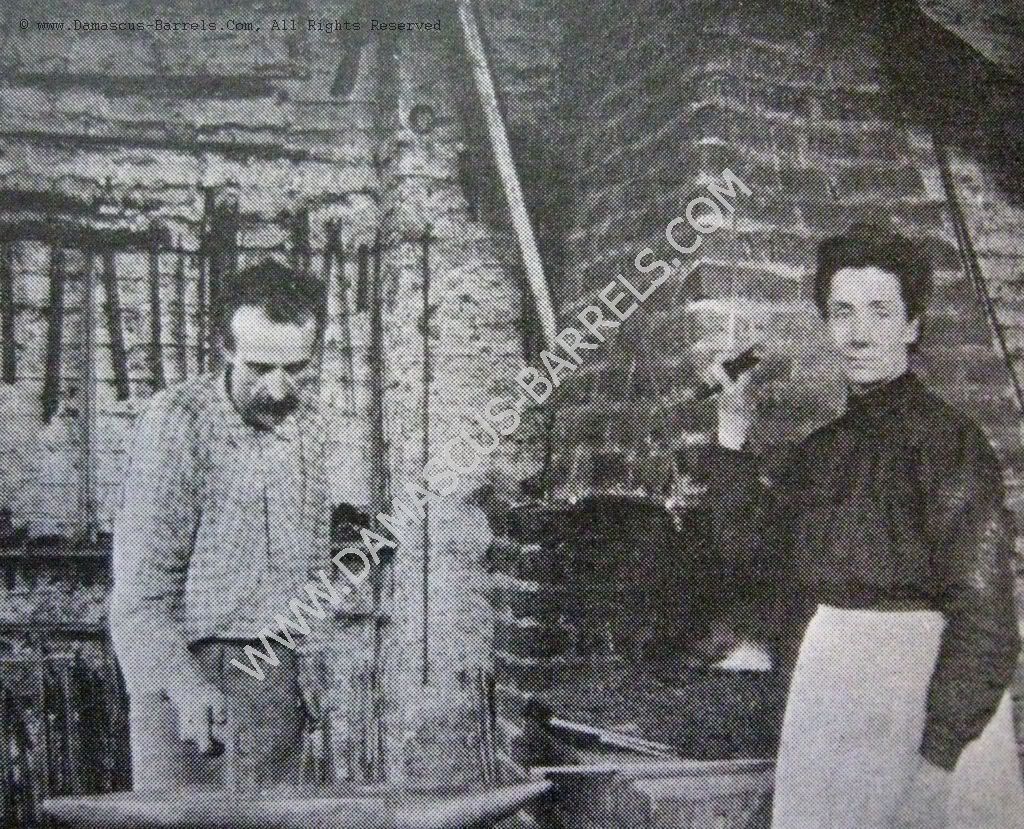 In some ways, things have not changed. This is an image of engravers working out of a kitchen. 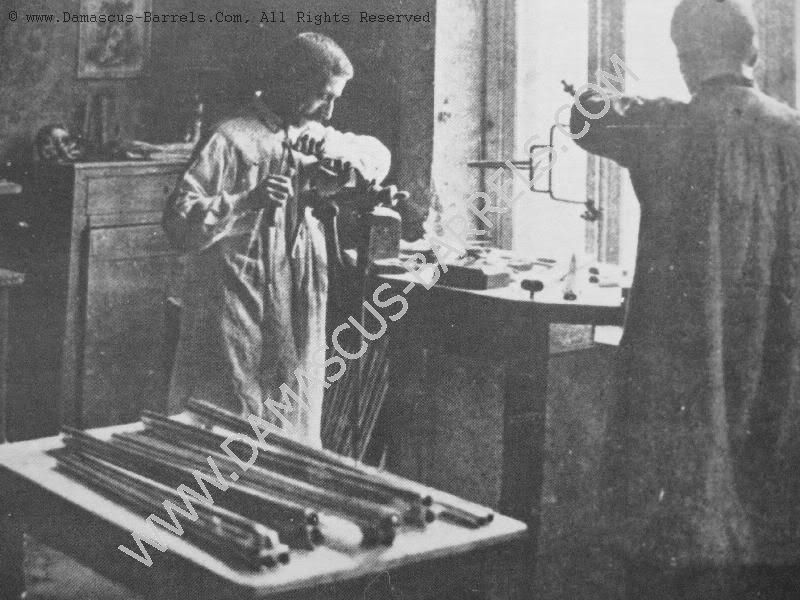 The Belgian Guild marching in a celebration. 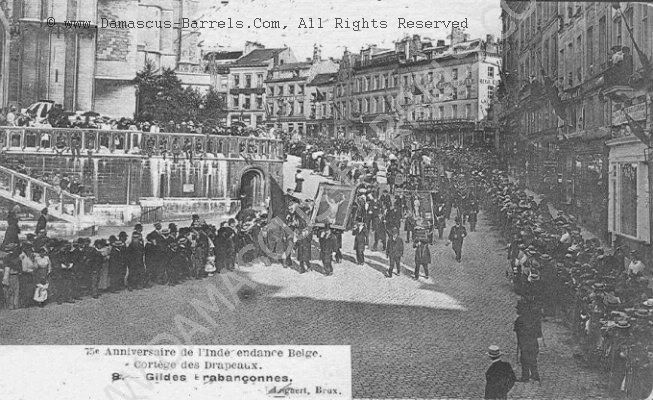 While the guilds were strong in Belgium, there does not appear to be anything as organized as the German system. Pete
Last edited by PeteM; 04/05/09 10:44 PM.
|
|
|
|
|
Joined: Dec 2001
Posts: 6,881
Sidelock
|

Sidelock
Joined: Dec 2001
Posts: 6,881 |
MP Sadly Deceased as of 2/17/2014
|
|
|
|
|
Joined: Dec 2001
Posts: 6,881
Sidelock
|

Sidelock
Joined: Dec 2001
Posts: 6,881 |
MP Sadly Deceased as of 2/17/2014
|
|
|
|
|
Joined: Aug 2007
Posts: 12,135 Likes: 420
Sidelock
|

Sidelock
Joined: Aug 2007
Posts: 12,135 Likes: 420 |
As always Wikepedia is a good source of info - : http://en.wikipedia.org/wiki/Guild "Like journey, the distance that could be travelled in a day, the title 'journeyman' derives from the French words for 'day' (jour and journée) from which came the middle English word journei. Journeymen were able to work for other masters, unlike apprentices, and generally paid by the day and were thus day labourers. After being employed by a master for several years, and after producing a qualifying piece of work, the apprentice was granted the rank of journeyman and was given documents (letters or certificates from his master and/or the guild itself) which certified him as a journeyman and entitled him to travel to other towns and countries to learn the art from other masters. These journeys could span large parts of Europe and were an unofficial way of communicating new methods and techniques, though by no means all journeymen made such travels - they were most common in Germany and Italy, and in other countries jorneymen from small cities would often visit the capital. After this journey and several years of experience, a journeyman could be received as master craftsman, though in some guilds this step could be made straight from apprentice. This would typically require the approval of all masters of a guild, a donation of money and other goods (often omitted for sons of existing members), and the production of a so-called masterpiece, which would illustrate the abilities of the aspiring master craftsman; this was often retained by the guild." The guilds were charitable and supported society. Some of the funds for the Meister event were probably earmarked for sons and widows of Masters that had expired. During the Medevial period when the guilds were in full force thru somewhat of a feudal tenure the municipalities basically were empowered by the emperor, who was empowered by God, to dole out the right to practice an art, a craft or trade as deemed by the Rath, or town council. This gave the guilds the right to practice a specific art, or division thereof, craft or trade. The guild were sort of self policed and for example determined what quanity of raw materials would be purchased/stockpiled and how many Journeymen could be under the tutelage of a Meister, as well as the pay for the Journeymen. The guild had a huge sense of honor or Ehrbarkeit( http://translate.google.com/translate?hl...l%3Den%26sa%3DG ).The Adoph article confirms that the apprentices weren’t required to be paid anything but the rules of the time stated that the master “must maintain his apprentice night and day in his house, give him board and attention, and keep him under lock and key.” I'm not positive of the source but it may have originated from "The Story of Nuremberg" by C. Headlam. The Master was supposed to impart all knowledge and "black magic" of his craft to the student. Upon completion of the Lehrjahre/apprentice period, they youngster was given funds and set out on his walkabout. There looks to have been a couple rungs above or laterally with the Meister: Techniker and Ingenieur. I guess that Austria closely followed the German model. Kind Regards, Raimey rse
Last edited by ellenbr; 04/05/09 09:43 PM.
|
|
|
|
|
Joined: Aug 2007
Posts: 12,135 Likes: 420
Sidelock
|

Sidelock
Joined: Aug 2007
Posts: 12,135 Likes: 420 |
I will concede and eat a few bites of my hat in that Germany Journeyman's pieces submitted to the guild of Masters, were sold. See GGCA( http://www.germanguns.com for purchase) publication No. 36, Spring 2008 at page 25 where there is an article where a percussion double owner inquires to Dr. Fritze, great grandson of Emil Karl Alexander Fritze and contact at the Museum in Suhl, ( http://www.waffenmuseumsuhl.de/ - I don’t know where the English button might be - http://www.gunmaker.org/www/wts/html/webinfo.nsf/DokuUNID/041129-60189-OM-8610666056?OpenDocument with more German ref. info) regarding info on the piece and it turned out to be E.K.A. Fritze’s journeyman piece. But the “trade gun” is much, much more than the plain-janes which are sometimes labeled “guild guns”. Actually it is closer to a masterpiece. Now E.K.A. Fritze didn’t do all the elaborate work but he did do the work representing what he had learned and within his discipline/capability/specialty. The rest of his work was outsourced just like what one would see in the making of a longarm for a firearms merchant during the period. The guild had an internal control mechanism, which was the Masters which allowed some Journeymen to continue while keeping their thumb on the rest of the group in order to protect their own interest. With the advances of the industrial revolution more and more hand tasks were performed by machine resulting in more output when more output was needed. Conflicts/Wars, etc. for the most part drove the production and peacetime found idle hands. So I think this is why you see a lot of the German influence in America where German Journeyman were attempting to break free from the hold of the Masters. Larger facilities were the recipients of the large contracts and in turn they had their own in-house journeyman programs. So the military and sporting began to diverge. For the most part, the basis of the info is from the article but with some yarn of my own. Kind Regards, Raimey rse
Last edited by ellenbr; 05/03/09 09:51 AM.
|
|
|
|
|
Joined: Nov 2005
Posts: 4,598
Sidelock
|
OP

Sidelock
Joined: Nov 2005
Posts: 4,598 |
An apprentice contract from England, 1891. This is for 5 years of service. It is very concerned with not revealing the "secrets" of the master. The pay rate begins at 5 shillings a week in the 1st year, increasing to 1 pound a week in the 5th year. The work day is 8am to 8pm except Saturday's 8am to 2pm. The part about the master supplying food is crossed out. I think it is interesting that this is a business form. So it must have been very commmon. 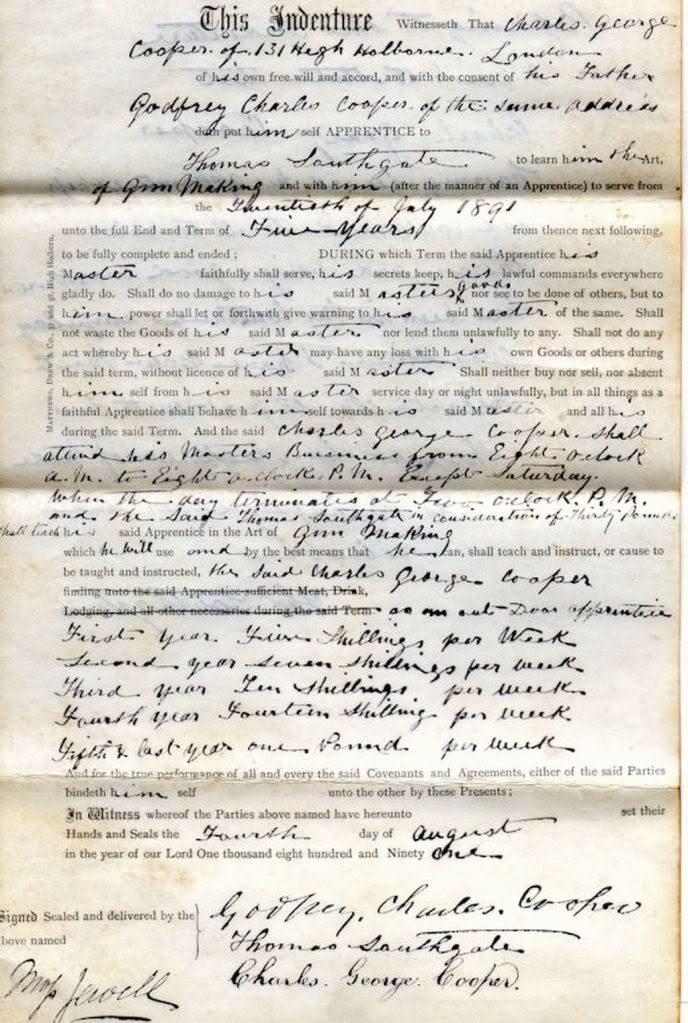 Pete
|
|
|
|
|
Joined: Jun 2004
Posts: 349
Sidelock
|

Sidelock
Joined: Jun 2004
Posts: 349 |
Some great posts there, thanks.
Raimey is of course correct when he connects journeyman to journee, French for day .
Journeymen were “qualified” as they had finished their apprenticeship periods but, as a means of gaining more experience and venture cash before setting up their own workshops they, now free to travel, moved around to work for different master-craftsmen and were paid by the day.
Apprenticeships were taken very seriously; the apprentice was effectively an indentured servant and the Master was “in loco parentis.” If the conditions of the indenture were sufficiently onerous, the apprentice/servant could be akin to a slave, like many of the Irish shipped to your East Coast in the 1660s.
The indenture shown by Pete M is a standard form and could be used by any trade. They were very common in the UK and Ireland well into the mid 1900s and even in my time a solicitor’s apprentice was a common occupation and he (or his parents) paid his master for the privilege of working as an unpaid glorified law clerk until qualification. Typically a farm worker or kitchen maid’s indenture was almost identical, without the clause for instruction. The blank space at the end could be used for detailing special items such as “three days absence will be given for the Tipperary Races.”
The snobbery of looking down on “trade” is a 19th century occurrence and derives from impecunious British monarchs funding their lifestyles by selling honours to wealthy merchants. (That is why many of the present day British aristos have a poorer bloodline than most good horses.) The recently ennobled distanced themselves from their till-grubbing past and disdained those from where they themselves had come.
The following excerpts from the 1627 will of a very wealthy English landowner give an idea of how ordinary an apprenticeship was in that era:
Item And my will and desire is that my executor do dispose of my sonne Samuell ........ to some honest and recommendable trade in the Cittye of London with all convenient speade and that in the meane tyme he be not overchardgeable to my wyfe especially for his apparell and schoolinge
Item I geve and bequeath onto the foresaid Beniamyn ....... my sonne the full some of ffortye pounds of lawfull mony to be paid onto him within six monthes after his apprentishipp shal be expired.
In my student days there used to be (still is?) a good restaurant in Paris called “Aux Charpentiers.” Way back the carpenters guild used to meet in an upstairs room and the place was full of scale models that were guild entry pieces.
Rs
K.
|
|
|
|
|
Joined: Nov 2005
Posts: 4,598
Sidelock
|
OP

Sidelock
Joined: Nov 2005
Posts: 4,598 |
Kerry, This is evidence that for a long time gun maker's apprentices in this country were indentured servants. Certainly in the 1700's and early 1800's. Even in the late 1800's and early 1900's a journeyman was not making a great deal of money. http://books.google.com/books?id=V7WtToEDvYsC&pg=PA16&dq=apprentiship+gunsmith#PPA16,M1http://books.google.com/books?id=WadJAAA...cad=0#PPA207,M1It is interesting that the practice was so wide spread in Britian as to even include solicitors. Apparently the apprenticeship in England had been 7 years at one point: The King and Company Of Gunmakers. 1733-1734
J Mandamus.
Mandamus to admit J.S. to his Freedom of the Gunmakers Company, having been educated in the Art and Mystery of a Gunsmith, and served seven Years Apprenticeship. The Company returned they were incorporated by Charter, by Char. 1, and set out the Charter, that no Person was intitled to his Freedom but those of the Trade residing in London, or within ten Miles thereof at Time of the Incorporation, and such of their Children as should serve seven Years Apprenticeship to that Art and Mystery ; and as to other Persons it left the Company at large to admit or reject as they thought proper and convenient, and they returned that they did not think proper to admit him. Objection was taken to the Return, that it did not answer the Suggestion, as to his being educated in the Art, etc., and serving seven Years Apprenticeship. Pete
|
|
|
|
|
Joined: Jul 2006
Posts: 1,164 Likes: 11
Sidelock
|

Sidelock
Joined: Jul 2006
Posts: 1,164 Likes: 11 |
In 1901 The Guardians of the Birmingham Proof House,voted to estabablish a technical training committee and training school. This course of action was a result of the initiative of Mr Samuel Allport a former Proof Master [deceased 1899].Mr Allport was a former Guardian and Chaiman of the Board.Previous to becoming Proof Master, he was a successful gun and rifle maker. He believed in a scientific approach to gun making backed by technical training and that it would be essential to the future of the Birmingham trade.[For example, as Proof Master he is credited with designing the lead crusher gun for establishing barrel pressure at various points in a gun barrel] The school despite its favourable begginings, closed in 1924. The reason being lack of response from the younger gun workers/ apprentices!Whilst I would agree technical training alone dose not create a Master gun maker, it would be decades before any real progress was made in the U.K. to advance the technology needed to compete in the international market.
Roy Hebbes
|
|
|
|
|
Joined: Nov 2005
Posts: 4,598
Sidelock
|
OP

Sidelock
Joined: Nov 2005
Posts: 4,598 |
Roy, Interesting history. I was not aware the British established a school. From the sound of it, it was a few years after the school in Liege. Here is a bit about Allport's crusher gauge. Report of the 56th annual meeting of the British Association for the Advancement of Science. Published by J. Murray, 1887 http://books.google.com/books?id=vzMUAAAAYAAJ&pg=PA820&dq=Samuel+Allport#PPA821,M1The instrument known as the ' crusher gauge ' is a cylindrical nozzle having an external screw to screw into any powder chamber. It is bored at one end to receive a perfectly fitting piston. On exploding powder in the chamber the piston delivers an impact upon a loose copper disc placed inside the crusher gauge, of which the rate of compressibility is ascertained previously. By carefully measuring the thickness of the copper disc before and after the experiment, the compression the disc has suffered is observed, and the powder force is deduced. Since the thickness of the barrel of a gun from breech to muzzle should diminish proportionally to the progressive decrement of gas pressure the lightest safe section can thus be found. This instrument has been screwed at equal distances along large guns for that purpose, and the principle seems capable of application to sporting guns. The paper then dealt briefly with the subject of impact.
The author exhibited a test gun of 73/100 of an inch calibre, designed for testing the pressures exerted by different powders upon the barrels of guns. The upper side of the barrel is pierced with six tapped holes, into which gun-metal stop-screws are screwed. On removing either of these, an instrument for measuring the pressure may be screwed on. The stem of the piston La this instrument extends to the inner surface of the barrel, and its outer extremity carries a toothed rack. This engages with a pinion, the axis of which carries an index finger ranging over a graduated arc.
On firing the gun, a gas-check wad upon passing the end of the piston-rod exposes it to the pressure of the gas then generated, forcing the piston upwards against a spiral spring and compressing it. The compression is automatically recorded on the graduated arc in terms of hundredths of a ton per square inch. By interposing a different piston the gun becomes a crusher gauge at the same places along the barrel, whereby a second test is established. Pete
|
|
|
|
|